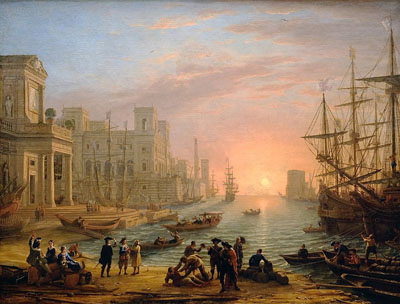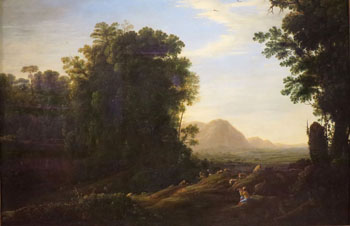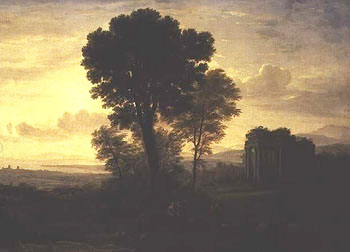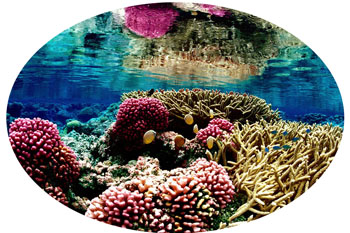Catholic Virtues
 |
 |
 |
 |
 |
 |
 |
True & False Paths to Happiness - XXXIII
The Harmonious Symphony of the
World of the Possibles
Sacral contemplation can also have as its object the sphere of the possibles, that is, of beings that could exist but do not exist. Any one who dedicates himself to this search for the possibles will see a true universe unfurl before him, since every existing being has similarities with countless beings that do not exist and will never exist.
But, how does one contemplate something that does not exist?
This possibility is easier to understand by going to the example of painting.
 The painter par excellence of non-existent but possible panoramas is the celebrated French artist Claude Lorrain (1600-1682). He could compose a city that does not exist, juxtaposing into reality things that either very rarely exist or do not exist at all.
The painter par excellence of non-existent but possible panoramas is the celebrated French artist Claude Lorrain (1600-1682). He could compose a city that does not exist, juxtaposing into reality things that either very rarely exist or do not exist at all.
He presents, for example, a city without defined streets by the sea, where ships are arriving to unload their goods. Two or three ships are coming in from the sea to the dock, where several groups of persons have gathered. Everything is calm and serene, with nothing of that agitated, intense and prosaic movement of today's wharves.
In this scenario you can feel the charm of the sea, the charm of the ship that returns from a voyage, which at that time was almost as risky as a voyage to the Moon is today.
The ship we see is coming from that wild new land that was then America – or perhaps from Asia – loaded with gold, gemstones, jewels, porcelains, carpets and spices.
The ship arrives at a quay lined with palaces. The beauty of the sea, the palaces, the riches and the spices that are arriving and will be unloaded are juxtaposed, pointing to the beauty of the journey and the beauty of commerce.
Living on the fringes of the sun
But the artist's great talent was to paint his scenes in a glorious light of a golden sun, which gives us the impression of a very light air, an unreal atmosphere, so very different from the pollution of modern megalopolises.

 This scene communicates the impression that the man who lives there has a kind of superior life, diaphanous and agreeable, in a world bathed in an ideal that comes from the sun or the sky: The individual feels himself to be in some way a dweller in the sun.
This scene communicates the impression that the man who lives there has a kind of superior life, diaphanous and agreeable, in a world bathed in an ideal that comes from the sun or the sky: The individual feels himself to be in some way a dweller in the sun.
The man who contemplates certain paintings by Claude Lorrain cannot help but feel as if he dwells mentally on the fringes of the sun, in those first golden rays of the sun still accessible to man. Or in a region so ethereal and so delicate that some rays of sunlight extend there in an enchanting way, even without being as golden as the sun.
In these paintings of Lorrain there is nothing stormy; there is no wind, not even a breeze. The characters move slowly, with majesty, distinction and a simple naturalness; the trees, so to speak , are standing in the air, as if to say, "I have reached the perfect point of my well-being, and here not even the wind can bother me or shake me. I am a tree, but with a kind of intelligence that is not of the vegetal kingdom."
It could be said that the tree feels the delicacy of the air around it, and that the air surrounds the tree with delights to which it is insensitive by nature, but not in the world created by this artist.
In all of this, man is transported into the marvelous.
The paintings of Claude Lorrain intimate the fact that, among the beauties of nature, there are some that are proportional to the natural order in which we live. But there are others so magnificent that they seem out of proportion to that order. They are so magnificent that they make us think of another universe, a world that can appear to us as unreal or non-existent, but to which our soul is irresistibly drawn.
The sea brims over with the horizon of the possible
Among these beauties of nature is the ocean. The sea has everything. It presents a horizon of the possibles. I realize that one of the reasons I like the sea so much is that it is highly suggestive of the possibles. For me, it is much more suggestive than the top of a mountain, for example. And the top of a mountain is a very beautiful thing!
 What enthuses me the most about the sea is not the coasts, but the idea that beyond the point where my eye can see there are worlds that I do not know. That tiny opening to them is just a sampling.
What enthuses me the most about the sea is not the coasts, but the idea that beyond the point where my eye can see there are worlds that I do not know. That tiny opening to them is just a sampling.
Then, my soul finds that repose which corresponds to the famous phrase of St. Augustine: "My God, we were created for Thee and our hearts are restless until they rest in Thee." We understand the vanitas vanitatum (vanity of vanities) of the things of this world. When one is placed before such horizons, one wants to linger there a while.
The paintings of Claude Lorrain and the consideration of the sea are appropriate ways to introduce us to the world of the possibles. It is the opposite of the world of Positivism, (1) a 19th-century school that still exercises its influences in our days. According to it, it is necessary to be hostile to everything that goes beyond the physical, tangible and scientific, and to thus carefully abstain from all useless speculations.
The possibles & creativity
If there is one capacity that many people want to have, it is creativity. Everyone wants to be creative, and thus open to themselves the portals of the most varied domains of human activity. Now, the relationship between the possibles and creativity is not difficult to establish: To create is to give a real existence to a possible.
Someone, for example, wants to build a tower. He has before his eyes sketches of a huge number of possible towers. The more numerous and more well-made these towers are and the more adroit the builder's choice, the more excellent the tower will be. In the choice he makes from the possibles lies his creativity. It is not viable to be a creative spirit without having a keen sense of what is possible.
 In this process, there is a certain moment when the figure of what he wants to build becomes so clear that deep in his soul the man releases a kind of outcry that expresses and symbolizes the thing. This moment, in relation to the general process, is more or less like the moment when, on one of those islands made of coral, the reddish bank that rises from the bottom of the ocean shows its head above the waters. And then it receives the first ray of sunlight.
In this process, there is a certain moment when the figure of what he wants to build becomes so clear that deep in his soul the man releases a kind of outcry that expresses and symbolizes the thing. This moment, in relation to the general process, is more or less like the moment when, on one of those islands made of coral, the reddish bank that rises from the bottom of the ocean shows its head above the waters. And then it receives the first ray of sunlight.
One might say that only that which is useful is beautiful. Not so! The whole process is beautiful, that whole work that began at the bottom of the sea until it reached the top and emerged as a coral reef. This is an image of the path that the possibles take in the human mind until they become reality.
The child can pass through a process by which he acquires two cognitions at the same time: that of the real world and that of the world of the possibles. Those first perceptions are prodigiously rich, which detonate that world of the possibles. On the other hand, what can prevail in him is a mania for the pure palpable reality, which is very noble in one sense, but extremely deficient in another.
One of the most suggestive things in literature and art is to allow us to enter the worlds of the possibles, worlds that we know are not real but that elevate our thinking. One of the highest expressions of the Catholic philosophical School of St. Victor (2) is to make us, by means of the real, come into contact with the unreal, with what our soul dreams of and longs for, like internal stairs that lead to Heaven. One who does this is not a dreamer: He is a thinker.

Continued

But, how does one contemplate something that does not exist?
This possibility is easier to understand by going to the example of painting.

Claude Lorrain: Seaport at Sunset, 1639
He presents, for example, a city without defined streets by the sea, where ships are arriving to unload their goods. Two or three ships are coming in from the sea to the dock, where several groups of persons have gathered. Everything is calm and serene, with nothing of that agitated, intense and prosaic movement of today's wharves.
In this scenario you can feel the charm of the sea, the charm of the ship that returns from a voyage, which at that time was almost as risky as a voyage to the Moon is today.
The ship we see is coming from that wild new land that was then America – or perhaps from Asia – loaded with gold, gemstones, jewels, porcelains, carpets and spices.
The ship arrives at a quay lined with palaces. The beauty of the sea, the palaces, the riches and the spices that are arriving and will be unloaded are juxtaposed, pointing to the beauty of the journey and the beauty of commerce.
Living on the fringes of the sun
But the artist's great talent was to paint his scenes in a glorious light of a golden sun, which gives us the impression of a very light air, an unreal atmosphere, so very different from the pollution of modern megalopolises.

Landscapes by Claude Lorrain

The man who contemplates certain paintings by Claude Lorrain cannot help but feel as if he dwells mentally on the fringes of the sun, in those first golden rays of the sun still accessible to man. Or in a region so ethereal and so delicate that some rays of sunlight extend there in an enchanting way, even without being as golden as the sun.
In these paintings of Lorrain there is nothing stormy; there is no wind, not even a breeze. The characters move slowly, with majesty, distinction and a simple naturalness; the trees, so to speak , are standing in the air, as if to say, "I have reached the perfect point of my well-being, and here not even the wind can bother me or shake me. I am a tree, but with a kind of intelligence that is not of the vegetal kingdom."
It could be said that the tree feels the delicacy of the air around it, and that the air surrounds the tree with delights to which it is insensitive by nature, but not in the world created by this artist.
In all of this, man is transported into the marvelous.
The paintings of Claude Lorrain intimate the fact that, among the beauties of nature, there are some that are proportional to the natural order in which we live. But there are others so magnificent that they seem out of proportion to that order. They are so magnificent that they make us think of another universe, a world that can appear to us as unreal or non-existent, but to which our soul is irresistibly drawn.
The sea brims over with the horizon of the possible
Among these beauties of nature is the ocean. The sea has everything. It presents a horizon of the possibles. I realize that one of the reasons I like the sea so much is that it is highly suggestive of the possibles. For me, it is much more suggestive than the top of a mountain, for example. And the top of a mountain is a very beautiful thing!

The ocean offers a horizon of the possible
Then, my soul finds that repose which corresponds to the famous phrase of St. Augustine: "My God, we were created for Thee and our hearts are restless until they rest in Thee." We understand the vanitas vanitatum (vanity of vanities) of the things of this world. When one is placed before such horizons, one wants to linger there a while.
The paintings of Claude Lorrain and the consideration of the sea are appropriate ways to introduce us to the world of the possibles. It is the opposite of the world of Positivism, (1) a 19th-century school that still exercises its influences in our days. According to it, it is necessary to be hostile to everything that goes beyond the physical, tangible and scientific, and to thus carefully abstain from all useless speculations.
The possibles & creativity
If there is one capacity that many people want to have, it is creativity. Everyone wants to be creative, and thus open to themselves the portals of the most varied domains of human activity. Now, the relationship between the possibles and creativity is not difficult to establish: To create is to give a real existence to a possible.
Someone, for example, wants to build a tower. He has before his eyes sketches of a huge number of possible towers. The more numerous and more well-made these towers are and the more adroit the builder's choice, the more excellent the tower will be. In the choice he makes from the possibles lies his creativity. It is not viable to be a creative spirit without having a keen sense of what is possible.

Coral island & reef sharks in Siam Bay, Thailand
One might say that only that which is useful is beautiful. Not so! The whole process is beautiful, that whole work that began at the bottom of the sea until it reached the top and emerged as a coral reef. This is an image of the path that the possibles take in the human mind until they become reality.
The child can pass through a process by which he acquires two cognitions at the same time: that of the real world and that of the world of the possibles. Those first perceptions are prodigiously rich, which detonate that world of the possibles. On the other hand, what can prevail in him is a mania for the pure palpable reality, which is very noble in one sense, but extremely deficient in another.
One of the most suggestive things in literature and art is to allow us to enter the worlds of the possibles, worlds that we know are not real but that elevate our thinking. One of the highest expressions of the Catholic philosophical School of St. Victor (2) is to make us, by means of the real, come into contact with the unreal, with what our soul dreams of and longs for, like internal stairs that lead to Heaven. One who does this is not a dreamer: He is a thinker.

Continued

- According to the positivist view, the "evolved man," strong and "enlightened" by Positivism, with his feet firmly placed on the ground, viewed the men of centuries past with contempt and even pity. We know what resulted from this conception! Auguste Comte (1798-1857) even founded a positivist church and religion. In London, the members of the London Positivist Society created a Church of Humanity with nothing supernatural or metaphysical, just the cult to the great men produced by humanity.
- The School of St. Victor, aka the Victorines, was a 12th century school based on the Augustine Abbey of St. Victor in Paris. Its characteristic linked to the topic of this article was its contemplation based on God as exemplary cause of Creation, which means that God is mirrored in the Universe He created. The Victorines looked for the satisfaction of all corporal and spiritual human senses as the final goal of such contemplation and a prefigure of the beatific vision. The principal names of this school are Hugh of St. Victor, Richard of St. Victor and Andrew of St. Victor.
Posted September 20, 2021





